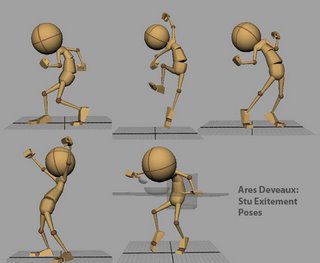At the end it got harder but it was fun anyway.
So, I finished Class 1 "Basic Foundation" and I have a few things to show you.
I was busy animating walks. It should be an easy thing since I have done it before right?!... How far from the truth. Now that I know the basic principles, being careful of applying them to the walk was not as straight forward as I thought it would be. Not only that, but this was my first time using the pose to pose method to do it. I still think layering is the best method of animating a walk but it was an awesome learning experience. I think now I understand a lot better how to work with that method. Also, using pose to pose forces you to plan better your animation and think of all the principles... For example, the overlap has to be in the poses already instead of applying them modifying the curves after the fact. You can of course still do that, but just to tweak it.
In short, pose to pose takes the control of the animation away from the computer, and that is a great thing, make you feel like you are really an animator.
Ok... Enough chit chat, let me show you the animations.
First, the progress reel of everything I did on class 1. I rendered all my animations and gave them a new look. Also some of the animations were refined for this version. This is what I have been doing for the past 3 months:
Because all the animation are on the progress reel I will not bother adding the last ones individually, but I will put this one since it shows the pose to pose process in two of its stages: Blocking and final.
blocking is when all your poses are assemble in the animation using hold keys (stepped in Maya) in such a fashion that is just like a 2D animation.
You can see both stages simultaneously on the movie. Look how many poses you can use when blocking (your mind can fill in the blanc completing the sense of motion). Doing that you take away the animation control from the computer. It is very important to do that because when you go from hold keys to spline the computer can make a mess if you are not careful:
Here are the planning pages for the vanilla walk:

and the personality walk:

This last planning was more to analyze what needed to be done to make it work in perspective.
Here are some more sketches I did to be posed in 3D. I am not showing the 3D images since they are on the progress reel:
Concern sketches:

Strength sketches:

Exhausted sketches:

Balance sketches:

Ok... That was all!!!!... Done with the animation basics... Next we will be concentrating on body mechanics. I think is going to be a lot of fun!










